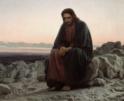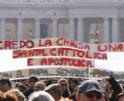
Spirituality

Pakaluk
What could be more ridiculous, as a Christian, than to celebrate the dedication of a building, and even to place that celebration on the universal calendar of the Church? But that is what Catholics do, on Aug. 5, the traditional date of dedication of the Basilica of St. Mary Major in Rome.
It seems ridiculous on scriptural grounds. Didn't Jesus say to the Samaritan woman that "the hour is coming, and now is, when the true worshipers will worship the Father in spirit and truth, for such the Father seeks to worship him. God is spirit, and those who worship him must worship in spirit and truth" (John 4:23-24). She observed that her people worshiped on the mount of Gerizim rather than the mount of Jerusalem. But Jesus told her that, in the new religion he was founding, worship would not be restricted to one place.
Or when the disciples drew the Lord's attention to the magnificence of the Temple, he told them without evident regret, "You see all these temple buildings, do you not? Truly, I say to you, there will not be left here one stone upon another, that will not be thrown down," (Mt 24:2).
Besides, great basilicas and cathedrals are found everywhere, and if we celebrate the dedication of one, why not many or all? Why not place the dedication of the Chartres cathedral on the universal calendar? Or have each diocese or nation celebrate its own local dedications -- if this is to be done at all -- such as the Basilica of the National Shrine of the Immaculate Conception, for the United States?
This is how I thought about the matter when I converted to Catholicism from Protestantism. But now I think differently because I have learned to trace things back.
That great basilica was built immediately after the Council of Ephesus's (431 AD) to celebrate that Council's definition of Mary as "Theotokos" or Mother of God. That definition affirms the unity of human and divine natures in Christ. If Mary gave birth to the Christ, and Christ is a divine person who assumed human nature, then she did not give birth to a mere "human being," somehow united to God, or merely to the human nature of Christ, but to God made man.
Ask yourself: Are you excited enough by what I just said that you and like-minded friends would be prepared to build a magnificent structure, as great as any of the Wonders of the Ancient World, to celebrate it? If not, then perhaps you do not love Christ or the truth as much as they. And then who begins to look ridiculous and on what basis?
So, the feast of this dedication celebrates the truth about Christ, and the love of Christians for the truth, and the diligence of the Church in safeguarding that deposit of faith.
The parable of the Pearl of Great Price, which was just read in Mass, applies to holy buildings as well. Yes, its first and original application is to the discovery of salvation in Christ. But then the parable asks of us a similar devotion and care to everything closely associated with that salvation.
To express that devotion, Christians early on composed a hymn, "Sub Tuum Praesidium confugimus, Sancta Dei Genetrix." "Dei Genetrix" is Latin for "Theotokos." The hymn is at least as old as the Basilica of St. Mary Major. Christians have sung it for 1600 years.
The feast of the Dedication of St. Mary Major used to be known as the feast of Our Lady of the Snows. The reason, according to an old story, is that a wealthy Roman and his wife had no children and in prayer asked for lights about how they could spend their wealth to assist the Church. The "Theotokos" appeared to him in a dream (and in some versions to the pope as well on the same night), indicating that she would like the wealth to be used for a church in her honor, and that she would give a sign as to where. The next day, although it was August, snow fell on the Esquiline hill, which the couple and the pope interpreted to indicate the place for the new church (the Basilica Liberiana, which predated St. Mary Major).
The old Catholic Encyclopedia gives a common view of good Catholic scholars: "From the fact that no mention whatever is made of this alleged miracle until a few hundred years later ... it would seem that the legend has no historical basis." The committee, which Benedict XIV established for the reform of the breviary in 1741, recommended that this story be removed. The feast was changed to its modern denomination by Pope St. Paul VI in 1969.
But I am uncomfortable with this skeptical holding. An argument from silence has force only if one sees no evidence where one might reasonably have expected it. But dreams are private revelations at best. Why should we have expected anyone to refer to it? And many donors wish that their gifts remain anonymous, not celebrated. On the other hand, why would one pick a snowfall in Rome in August for a fabricated story? And what would be the motive? And how could it have gained initial acceptance? But from the later Guadalupe and Lourdes miracles we see an analogy. And the widespread cult of Our Lady of the Snows is itself evidence.
- Michael Pakaluk, an Aristotle scholar and Ordinarius of the Pontifical Academy of St. Thomas Aquinas, is a professor in the Busch School of Business at the Catholic University of America. He lives in Hyattsville, MD, with his wife Catherine, also a professor at the Busch School, and their eight children. His latest book is "Mary's Voice in the Gospel of John" available from Amazon.
Recent articles in the Spirituality section
-
Masters week foreknowledgeMichael Pakaluk
-
Why is Lent 40 days?Michael Pakaluk
-
The eloquent ambiguity of 'I believe'Bishop Robert Barron
-
You don't get what you pay forMichael Pakaluk
-
The witness of a consecrated lifeBishop Robert Barron























